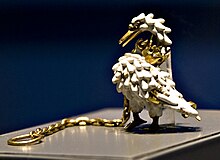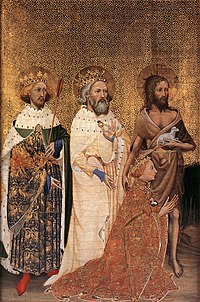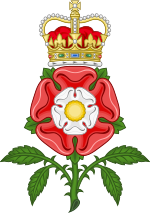
The Most Noble Order of the Garter is an order of chivalry founded by Edward III of England in 1348. The most senior order of knighthood in the British honours system, it is decoration outranked in precedence only by the Victoria Cross and the George Cross. The Order of the Garter is dedicated to the image and arms of Saint George, England's patron saint.

The House of Lancaster was a cadet branch of the royal House of Plantagenet. The first house was created when King Henry III of England created the Earldom of Lancaster—from which the house was named—for his second son Edmund Crouchback in 1267. Edmund had already been created Earl of Leicester in 1265 and was granted the lands and privileges of Simon de Montfort, 6th Earl of Leicester, after de Montfort's death and attainder at the end of the Second Barons' War. When Edmund's son Thomas, 2nd Earl of Lancaster, inherited his father-in-law's estates and title of Earl of Lincoln he became at a stroke the most powerful nobleman in England, with lands throughout the kingdom and the ability to raise vast private armies to wield power at national and local levels. This brought him—and Henry, his younger brother—into conflict with their cousin King Edward II, leading to Thomas's execution. Henry inherited Thomas's titles and he and his son, who was also called Henry, gave loyal service to Edward's son King Edward III.

The King's Body Guard of the Yeomen of the Guard is a bodyguard of the British monarch. The oldest British military corps still in existence, it was created by King Henry VII in 1485 after the Battle of Bosworth Field.

The coat of arms of England is the coat of arms historically used as arms of dominion by the monarchs of the Kingdom of England, and now used to symbolise England generally, but not officially. The arms were adopted c.1200 by the Plantagenet kings and continued to be used by successive English and British monarchs; they are currently quartered with the arms of Scotland and Ireland in the coat of arms of the United Kingdom. Historically they were also quartered with the arms of France, representing the English claim to the French throne, and Hanover.

The White Rose of York is a white heraldic rose which was adopted in the 14th century as a heraldic badge of the royal House of York. In modern times, it is used more broadly as a symbol of Yorkshire.

The Red Rose of Lancaster was the heraldic badge adopted by the royal House of Lancaster in the 14th century. In modern times it symbolises the county of Lancashire. The exact species or cultivar which it represents is thought to be Rosa gallica officinalis.

The Tudor rose is the traditional floral heraldic emblem of England and takes its name and origins from the House of Tudor, which united the House of Lancaster and the House of York. The Tudor rose consists of five white inner petals, representing the House of York, and five red outer petals to represent the House of Lancaster.

The Wilton Diptych is a small portable diptych of two hinged panels, painted on both sides, now in the National Gallery, London. It is an extremely rare survival of a late medieval religious panel painting from England. The diptych was painted for King Richard II of England, who is depicted kneeling before the Virgin and Child in what is known as a donor portrait. He is presented to them by the English saints King Edmund the Martyr, King Edward the Confessor and patron saint, John the Baptist. The painting is an outstanding example of the International Gothic style, and the nationality of the unknown artist is probably French or English.
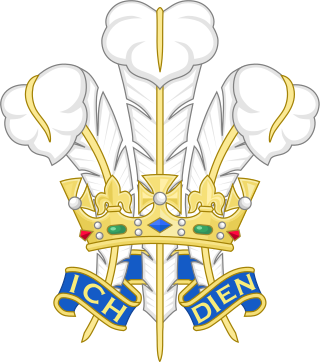
The Prince of Wales's feathers are the heraldic badge of the Prince of Wales, the heir to the British throne. The badge consists of three white ostrich feathers encircled by a gold coronet. A ribbon below the coronet bears the German motto Ich dien. As well as being used in royal heraldry, the feathers are sometimes used to symbolise Wales itself, particularly in Welsh rugby union and Welsh regiments of the British Army.

The coat of arms of Ireland is blazoned as Azure a harp Or, stringed Argent. These arms have long been Ireland's heraldic emblem. References to them as being the arms of the king of Ireland can be found as early as the 13th century. These arms were adopted by Henry VIII of England when he ended the period of Lordship of Ireland and declared Ireland to be a kingdom again in 1541. When the crowns of England, Scotland and Ireland were united in 1603, they were integrated into the unified royal coat of arms of kingdoms of England, Scotland and Ireland. The harp was adopted as the emblem of the Irish Free State when it separated from the United Kingdom in 1922. They were registered as the arms of Ireland with the Chief Herald of Ireland on 9 November 1945.
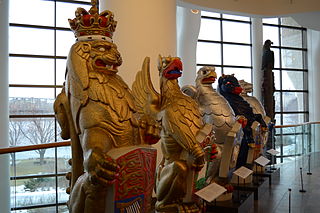
The Queen's Beasts are ten heraldic statues representing the genealogy of Queen Elizabeth II, depicted as the Royal supporters of England. They stood in front of the temporary western annexe to Westminster Abbey for the Queen's coronation in 1953. Each of the Queen's Beasts consists of a heraldic beast supporting a shield bearing a badge or arms of a family associated with the ancestry of Queen Elizabeth II. They were commissioned by the British Ministry of Works from the sculptor James Woodford, who was paid the sum of £2,750 for the work. They were uncoloured except for their shields at the coronation. They are now on display in the Canadian Museum of History in Gatineau, Quebec.

A Royal Badge for Wales was approved in May 2008. It is based on the arms borne by the thirteenth-century Welsh prince Llywelyn the Great, with the addition of St Edward's Crown atop a continuous scroll which, together with a wreath consisting of the plant emblems of the four countries of the United Kingdom, surrounds the shield. The motto which appears on the scroll, PLEIDIOL WYF I'M GWLAD, is taken from the National Anthem of Wales and is also found on the Welsh designs for £1 coins minted from 1985 until 2000. The badge formerly appeared on the covers of Assembly Measures; since the 2011 referendum, it now appears on the cover of Acts passed by the Senedd and its escutcheon, ribbon and motto are depicted on the Welsh Seal.

A livery collar or chain of office is a collar or heavy chain, usually of gold, worn as insignia of office or a mark of fealty or other association in Europe from the Middle Ages onwards.

The House of Beaufort is an English noble and quasi-royal family which originated in the fourteenth century as the legitimated issue of John of Gaunt, 1st Duke of Lancaster by Katherine de Roet. Gaunt and Swynford had four children: John Beaufort, 1st Earl of Somerset (1373–1410); Cardinal Henry Beaufort, (1375–1447), Bishop of Winchester; Thomas Beaufort, 1st Duke of Exeter (1377–1426) and Joan Beaufort, Countess of Westmorland (1379–1440). When Gaunt finally married Swynford as his third wife in 1396, the Beauforts were legitimized by Pope Boniface IX and by royal proclamation of the reigning monarch King Richard II the following year.

The White Greyhound of Richmond is one of the Queen's Beasts commissioned for display at the coronation of Queen Elizabeth II in 1953. A stone copy can also be found in the Royal Botanic Gardens, Kew.

The royal standards of England were narrow, tapering swallow-tailed heraldic flags, of considerable length, used mainly for mustering troops in battle, in pageants and at funerals, by the monarchs of England. In high favour during the Tudor period, the Royal English Standard was a flag that was of a separate design and purpose to the Royal Banner. It featured St George's Cross at its head, followed by a number of heraldic devices, a supporter, badges or crests, with a motto—but it did not bear a coat of arms. The Royal Standard changed its composition frequently from reign to reign, but retained the motto Dieu et mon droit, meaning God and my right; which was divided into two bands: Dieu et mon and Droyt.

The Dunstable Swan Jewel is a gold and enamel brooch in the form of a swan made in England or France in about 1400 and now in the British Museum, where it is on display in Room 40. The jewel was excavated in 1965 on the site of Dunstable Friary in Bedfordshire, and is presumed to have been intended as a livery badge given by an important figure to his supporters; the most likely candidate was probably the future Henry V of England, who was Prince of Wales from 1399.

The Tudor Crown, also known as the Imperial Crown, is a widely used symbol in the heraldry of the United Kingdom. In use officially from 1902 to 1953 and again from 2022, it represents both the British monarch personally and "the Crown", meaning the sovereign source of governmental authority. As such, it appears on numerous official emblems in the United Kingdom, British Empire and Commonwealth.

In heraldry, the royal badges of England comprise the heraldic badges that were used by the monarchs of the Kingdom of England.

The Bohun swan, also known as the Bucks Swan, was a heraldic badge used originally in England by the mediaeval noble family of de Bohun, Earls of Hereford, and Earls of Essex.


